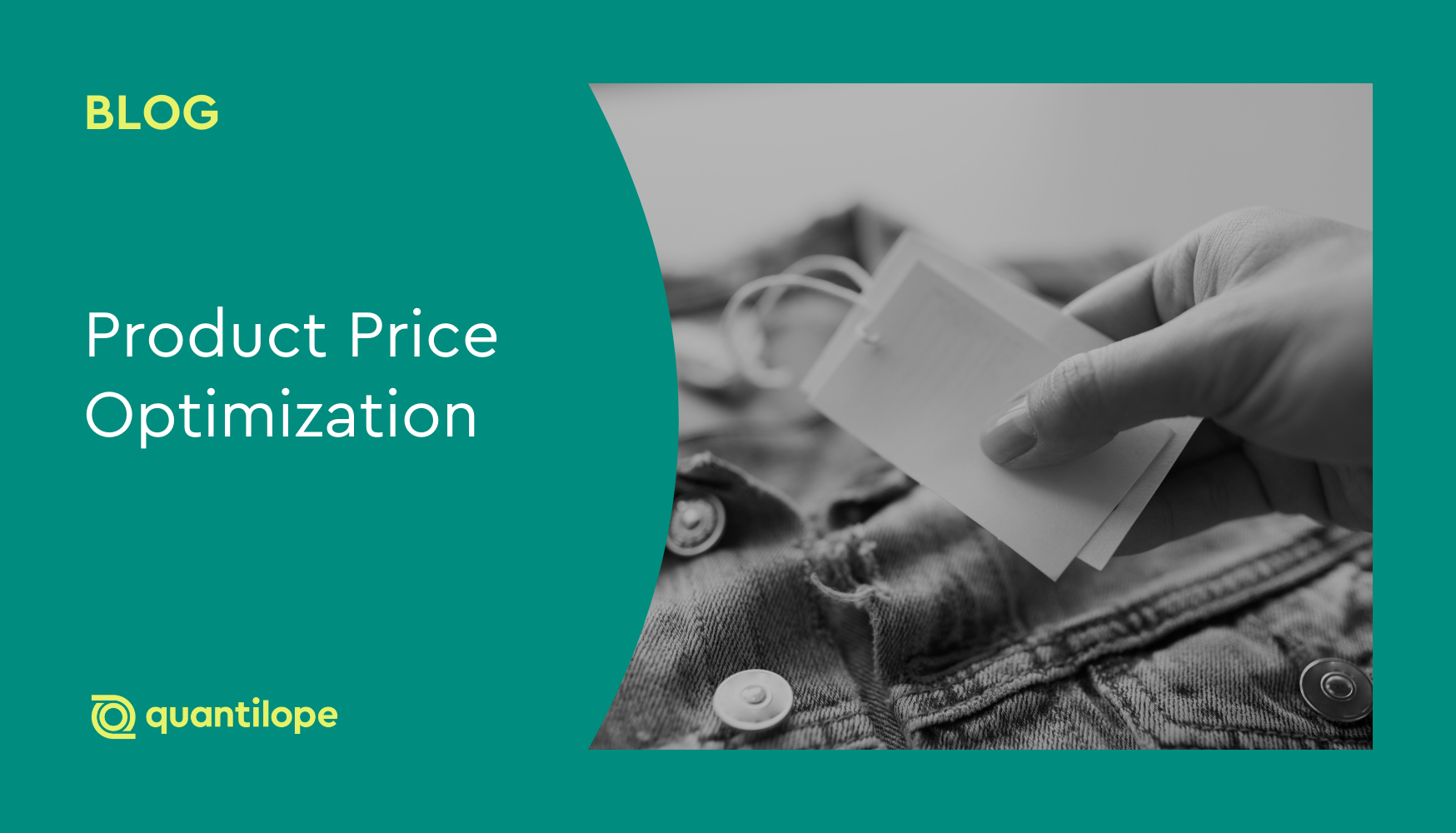Most businesses would say that one of their top aims is to grow profits - a simple goal, but not always a simple process to get there. Other businesses may aim to increase their market share, while others may aim to attract new customer interest, focusing on profits and market share at a later time. A key step in achieving any goal is finding the optimal price that consumers will pay for your product. So how do businesses go about establishing their pricing rules?
In this blog, we look at how using a price optimization tool can inform a pricing strategy that takes into account both business and consumer needs.
Table of Contents:
- What is price optimization?
- Why is setting the right price challenging?
- What are the most common pricing strategies?
- How to calculate an optimal price point
What is price optimization?
Price optimization is the process of finding the ideal price point for a business’s goals. Again, that goal might be to gain the largest profit possible, achieve the highest conversion, or attract the most consumer interest. All these various goals might lead to a different price for a product, which is what makes price optimization so important. It’s the price people will pay without feeling the price point is too high or too low, and at the same time, will achieve business goals.
Back to Table of Contents
Why is setting the right price challenging?
Setting prices seems simple enough, but in fact, is quite a challenge given so many variables that feed into what customers will pay for a product at a certain moment in time.
Price setting should take into account the product features (and how these compare with competitors), what customers value in the proposition, and ultimately, what customers will pay for it! The price consumers will pay for a product may also differ between products sold in-store and ones sold through e-commerce.
With the above factors in mind, it’s also important to note that one price may not fit all. Different types of customers are prepared to pay different prices, and that price will further fluctuate according to variables like seasonality, the occasion for spending, how much money they have at the present time, and the overall economic situation. This is where customer segmentation can play a central part in price optimization; it’s crucial to know your customer segments so that you understand each customer type’s price sensitivity (aka, their reaction to price changes).
Knowing how customers react to initial prices and price changes allows a business to set prices confidently for each of their audiences, tailor prices to different customer needs (perhaps with different pricing tiers or added features in a product), and set the best price for their specific goals.
Back to Table of Contents
What are the most common pricing strategies?
We know what price optimization is and the challenges that can come with it, so how does one go about establishing a pricing strategy?
There are a number of ways to set prices, and some of the best pricing strategies tend to be a combination of two or more approaches; any one strategy on its own might not fairly represent each of the different consumer types a business caters to (and what they’re each willing to pay). Below are a just few examples of common pricing strategies:
A value-based strategy sets a price based on how much consumers feel the product is worth. This is a strong foundation to set prices, as when all is said and done, a product is only worth what someone will actually pay for it. It does however require market research to understand what informs consumer perceptions of reasonable price parameters.
A competitor-based strategy considers competitor pricing as its benchmark and prices accordingly. This can mean setting prices lower than competitors to pull in price-sensitive customers, or setting them higher if the business perceives its offer to be of higher quality. Without adequate research, a business lacks information on why a price point is deemed acceptable from the consumer's point of view.
A cost-plus strategy bases pricing on manufacturing or production costs and the desired profit margin. This is a very functional and logical strategy but lacks insights into consumer motivations - which is why it might be paired with another consumer-centric pricing strategy to find the sweet spot when it comes to pricing - such as value-based pricing or dynamic pricing.
Dynamic pricing is a strategy in which prices fluctuate according to demand and competitor pricing at any moment in time. For example, the price of hotel rooms might increase when there is a popular event nearby, or decrease when there’s a surplus of empty rooms and the hotel is willing to sell at a lower price.
Regardless of your strategy, all pricing decisions start with an initial price - the price that the customer first becomes familiar with and which forms a baseline for their perception of your product’s value over time. If you subsequently apply a promotional price to your product (a special cut-price offer), the customer will use that baseline price to evaluate how good a deal they are being offered. In addition, businesses selling short life-cycle products such as seasonal clothing or flights often make use of discounted prices to ensure they sell all stock in time.
A final (and important) note on pricing strategies: within pricing models, there may be pricing tiers. This is particularly common amongst service providers, who offer different levels of service to meet different levels of customer needs. For example, a streaming service might offer a basic as well as a premium service, with a higher price paid for the removal of ads and a free version with minimal accessibility to features. Similarly, a carwash might offer bronze, silver, and gold levels of cleaning/services.
Back to Table of Contents
How to calculate an optimal price point
Knowing that consumer research is key to setting the right price, how does a business go about understanding customer behavior and how it should feed into its pricing decisions?
Successful product pricing should be guided by a combination of historical data and real-time information that will predict how customers are likely to react to different price levels. Relevant data includes sales data, online customer reviews, churn rates, demographics, and current customer behavior.
As capturing real-time consumer metrics is kind of our bread and butter, we put together a few steps to follow when setting an optimal price point for your product offering:
Gather input data
There are two main methods that are best suited for collecting consumer reactions to a variety of possible price points; both of which are quantitative research methods that employ machine learning models to determine which prices are considered ‘optimal’.
The first is known as a Van Westendorp, or, Price Sensitivity Meter (PSM) which works very well for commonly bought consumer packaged goods - those that research respondents can easily visualize when giving their views on pricing. The method works by presenting a product or product concept, then asks four specific pricing questions:
-
At what price would you consider the product to be so expensive that you would not consider buying it?
-
At what price would you consider the product to be priced so low that you would feel the quality couldn’t be very good?
-
At what price would you consider the product starting to get expensive, so that it is not out of the question, but you would have to give some thought to buying it?
-
At what price would you consider the product to be a bargain—a great buy for the money?
Using feedback from the above questions, data analysis then goes to work to determine which price would attract the greatest revenue, as well as degrees of price elasticity (how a price change would affect consumer choices).
The second common pricing strategy is Choice-based Conjoint. This approach can be considered the most sophisticated and elaborate version of pricing research. Various product attributes (of which price is just one) are combined into a complete product concept and presented to respondents in a way similar to how they would go about their selection process in a store or online. Respondents choose their favorite product, thereby revealing the combination of product features and price that most appeals to them.
A great advantage to choice-based conjoint is that price acceptance is measured indirectly, and the price levels can be decided in relation to the characteristics of other product features (e.g. material, feature integration, etc.). This method establishes the importance of price in a holistic scenario (again, reflecting the most realistic shopping experience). Brands can also include competitor concepts in the options shown to respondents, indicating how the competitive landscape impacts a business’s offer and acceptable price levels.
In addition to the above quantitative approaches, brands can also leverage qualitative data for valuable insights into the impact of price on purchase decisions. Loosely structured interviews allow for in-depth feedback on your product proposition, how it compares to competitors, and what motivates purchase decisions.
Quantify value
Having gathered data on what customers value in a product, a business will then be in a position to identify its value metric. A value metric is simply how your customers perceive the value of your product for what they’re paying for it. In the live entertainment market, it might be the price of a premium seat vs. general admission; for a fitness app it might be the number of workout videos available; for a kitchen appliance, it might be the number of features that come with it.
Whatever price you set for a product, that price should reflect the customer needs in that market and have a value metric attached to justify your pricing decision.
Review the data and set your prices
Now that you’ve collected data and attached a value metric to your product, it’s time to review and finalize your prices!
Data analysis will reveal which features of your product are valued most highly - and this may well differ by customer type. As mentioned earlier, establishing customer segments can help your business to set competitive pricing according to varying customer needs. For example, older customers may value better concert or event seats and be willing to pay more, while younger generations will pay for the cheapest seats they can afford.
Leverage consumer data to establish appropriate pricing tiers according to the willingness to pay for different products or features.
Monitor your prices and adjust as needed
You didn’t think it would be as simple as collecting data and setting prices, did you?
Customer reactions to pricing fluctuate according to a variety of factors, which is why optimal pricing is rarely set in stone. Markets change, competitors launch new products, and the money in consumers’ pockets rises and falls. For this reason, it’s important to monitor which metrics products perform well on, what contributes to customer satisfaction, and what happens to sales when external factors change or products are tweaked. This means ongoing research to understand where a product, positioning, or pricing can be adjusted to maximize appeal at certain moments in time.
Don’t stress! With quantilope’s insights automation platform, businesses have real-time access to pricing data whenever they need it. By leveraging the platform’s advanced pricing methods, brands can feel confident that they have identified the optimal price point for their product offering. Whether you opt for Choice-Based Conjoint Analysis, Price Sensitivity Meter, or inColor - a video-based qualitative solution, quantilope makes it simple to form data-driven pricing strategies that keep up with price changes in your category and maximize customer satisfaction.
To discuss which price optimization solution is best for your business, get in touch below!



.png)
